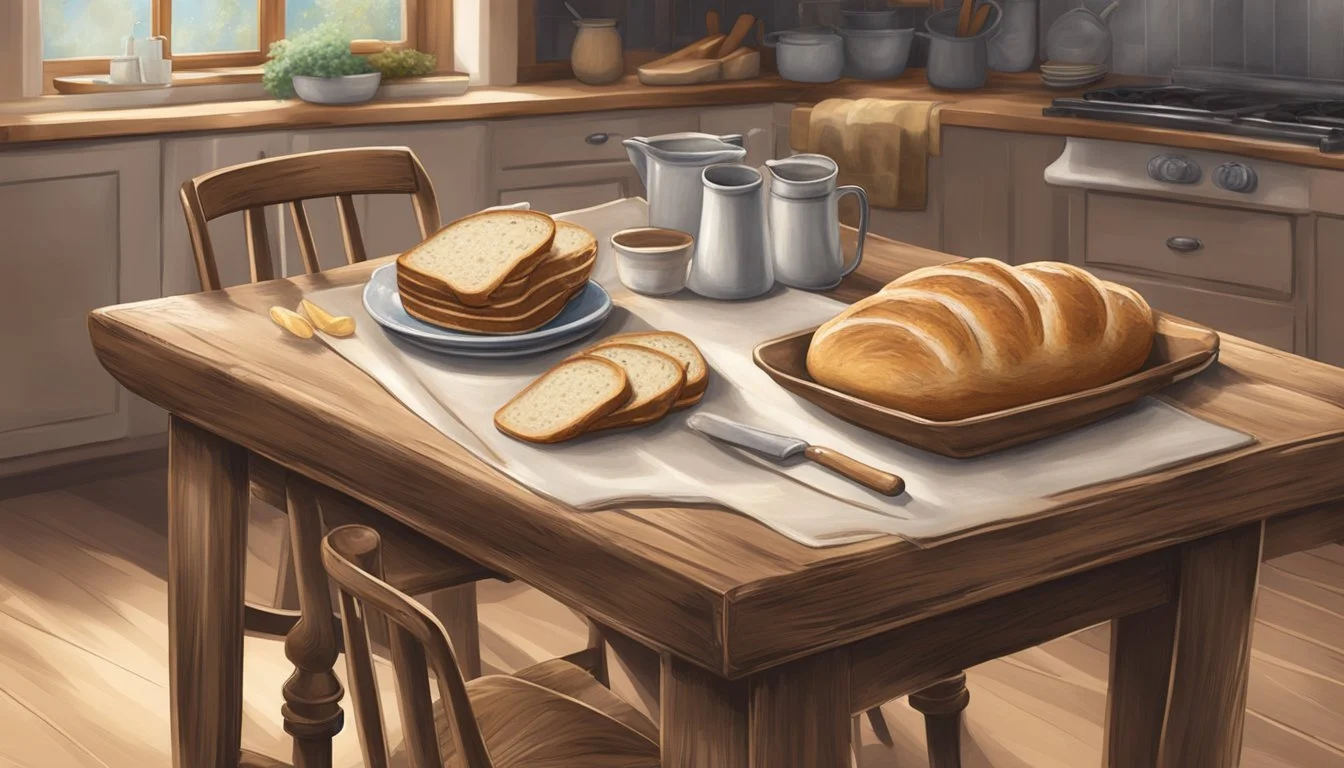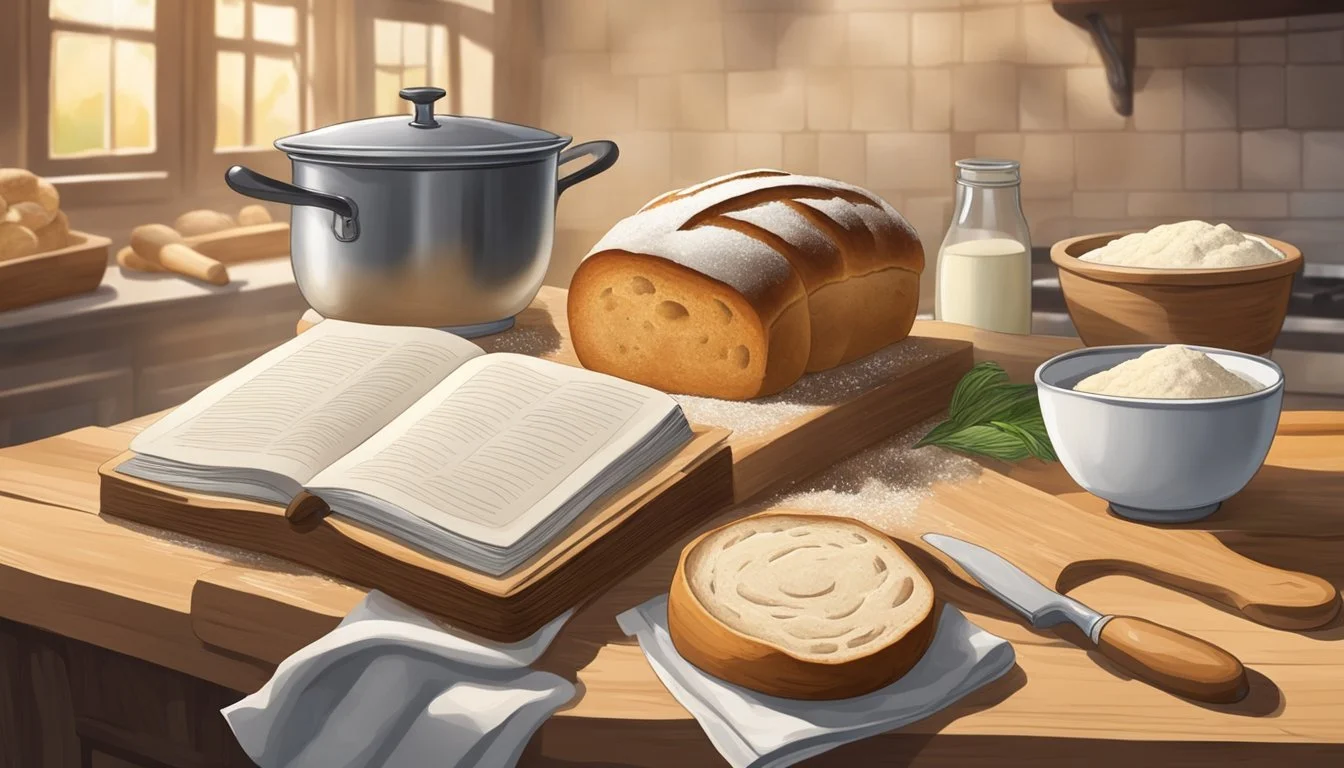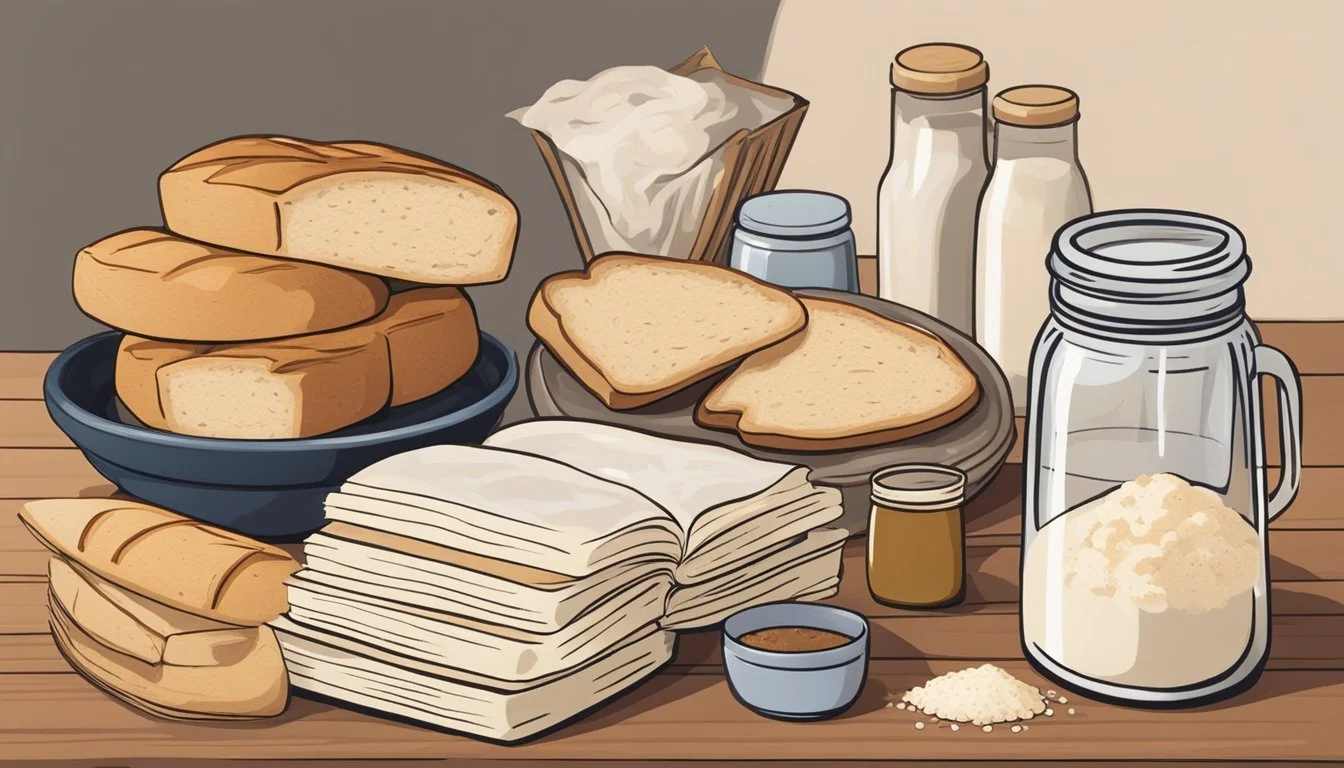The Best Sourdough Bread Books for Beginners and Pros
A Comprehensive Guide
Sourdough bread (What wine goes well with bread?)-making involves a timeless baking tradition, and in recent years it has flourished, turning into a favorite hobby and craft for many across the globe. It merges the simplicity of basic ingredients with the complexity of fermentation process, creating loaves that are distinctive in flavor and texture. Whether one is a beginner eager to craft their first homemade sourdough loaf or a seasoned baker looking to refine their craft, a plethora of books are available to guide through the intricacies of sourdough baking.
The mastery of sourdough bread starts with understanding the principles behind the starter, the fermentation process, and the baking itself. Resources designed for beginners offer step-by-step introductions, ensuring a foundational grasp of the necessary techniques and methods to start the sourdough journey with confidence. Books like "Starter Sourdough" and "Sourdough Cookbook for Beginners" provide insights to make sourdough more accessible, helping to dispel common myths and obstacles that might otherwise intimidate novices.
For the experienced baker, advanced sourdough books push the boundaries of what can be achieved with flour, water, salt, and yeast. Through comprehensive guides like "Flour Water Salt Yeast" by Ken Forkish, professional bakers and amateurs alike can delve deeper into sophisticated techniques and gain insights into crafting artisan bread and pizza. (What wine goes well with pizza?) These resources often include a myriad of recipes, detailed photos, and expert tips to enhance skills and inspire a creative approach to sourdough baking.
Getting Started with Sourdough
Embarking on the journey of baking sourdough bread involves understanding the underlying science, preparing a healthy starter, and having the right tools and ingredients. This section will guide you through these essentials, culminating in baking your first basic sourdough loaf.
Understanding Sourdough Fundamentals
Sourdough bread stands apart due to its natural fermentation process, involving wild yeast and bacteria. This fermentation not only leavens the bread but also enhances flavor and aids in digestibility. Beginners should focus on grasping the science that fuels sourdough culture development and the variables affecting fermentation, such as temperature and hydration.
Creating and Maintaining Your Starter
A robust sourdough starter is the backbone of great sourdough bread. It's a mixture of flour and water that captures wild yeast and bacteria from the environment. To create a starter, combine equal parts organic flour and lukewarm water in a jar, and let it sit in a warm place. Regular feeding—discarding part of the starter and replenishing it with fresh flour and water—is crucial to maintain a lively sourdough culture.
Essential Tools and Ingredients
Successful sourdough baking requires some essential tools and ingredients. Beginners will find that accurate measuring devices (such as scales), mixing bowls, a dough scraper, and a proofing basket contribute greatly to the process. Use different flours, like all-purpose, whole-grain, or rye, to experiment with flavors and textures. Always aim for high-quality, organic ingredients to ensure the best results.
The First Loaf: A Basic Sourdough Recipe
For your first sourdough loaf, simplicity is key. Here's a straightforward recipe to get started:
Mix: Combine 100g of active sourdough starter with 375g of water and mix until dissolved. Add 500g of bread flour and 10g of salt. Mix until all ingredients are well incorporated.
Bulk Ferment: Let the dough rest for bulk fermentation, typically for four to six hours at room temperature, with occasional folds.
Shape and Proof: Shape the dough into a loaf and let it proof in a well-floured basket until it passes the poke test.
Bake: Heat your oven with a baking stone or Dutch oven inside to 230°C (450°F). Transfer the bread into the oven and bake for about 40 minutes, or until the crust is a deep brown.
Remember: the key to mastering sourdough is practice and patience as you hone the art of fermentation and develop your bread-making skills.
Mastering Sourdough Techniques
Mastering the art of sourdough baking is about precision in techniques and understanding the science of fermentation. For both beginners and professional bakers, the ability to create the perfect loaf involves finely-tuned skills in kneading and shaping, as well as scoring and baking.
Kneading and Shaping
Proper kneading develops the gluten structure necessary for a strong dough, which ultimately leads to a well-risen loaf. Shaping sourdough is an equally crucial skill; it defines the bread's final structure and appearance. Bakers should practice:
Stretch and fold techniques: Encourages gluten development without overworking the dough.
Bench rest: Allows the dough to relax before final shaping, improving elasticity.
Tension building: When shaping, one must create surface tension to help the loaf maintain its shape during proofing.
Scoring and Baking
Scoring is more than just aesthetics; it's a technique to control where the bread will expand during baking. The oven should be preheated well, often with a baking stone or dutch oven, to ensure:
Proper oven spring: Slashing the dough assists in its upward expansion.
Crust development: A hot oven initiates a strong crust formation, pivotal for texture and flavor.
Steam introduction: Helps in achieving a glossy, crispy crust. Professional bakers often use a steam-injected oven or alternative methods, like ice cubes or a water pan, to replicate the effect.
Advanced Fermentation Methods
Sourdough baking is centered around fermentation, which can be manipulated for flavor and texture:
Levain creation and maintenance: Crafting a robust starter culture is key for a consistent bake.
Hydration levels: Adjusting the water-to-flour ratio impacts the dough's texture; higher hydration often leads to a more open crumb with larger holes.
Extended fermentation: Can be done in a cold environment (like a refrigerator) to enhance sour flavors and improve the dough's digestibility. This is known as retarding the proof.
AppBundle\Entity\Technique plays a pivotal role in every step of sourdough baking. A baker's understanding of these methods not only enhances their baking skills but also expands their capacity to experiment with different types of artisan breads, pushing the boundaries of sourdough's vast potential.
Exploring Sourdough Variations
Sourdough offers a vast canvas for bakers to explore different grains, enrichment options, and global traditions, each with unique flavors and textures.
Rye and Whole-Wheat Breads
Bakers harnessing the tangy potential of sourdough often incorporate rye or whole-wheat flour. These robust flours complement the naturally developed acidity, yielding breads with a deeper, more complex taste. Artisan sourdough books might guide readers through recipes for hearty whole grain loaves, offering a nourishing alternative to standard white flour varieties.
Sourdough Enriched Breads and Pastries
The inclusion of fats and sweeteners transforms basic sourdough into enriched bread like brioche or flaky croissants. These rich, tender breads offer a counterpoint to traditional sourdough's chewy texture, adding a luxurious dimension to the baker's repertoire. Beginners might start with simple sourdough cinnamon-sugar doughnuts to acquaint themselves with the principles of enrichment.
International Sourdough Styles
Globe-trotting through sourdough books, enthusiasts will discover a world of breads steeped in cultural significance. From the crisp crust of a French baguette to the soft, pillowy base of an Italian pizza, sourdough's versatility shines. Books may delve into New World Sourdough recipes or classic European styles, offering a mix of authenticity and innovation.
Creative Sourdough Experiments
For those ready to break the mold, sourdough marble rye bread, sourdough pretzels, and other inventive variations await. Experimenting with different shapes, flavorings, and techniques opens a gateway to original creations that redefine artisan bread. Taste and texture can take on new dimensions, as bakers challenge traditional expectations of sourdough, one recipe at a time.
Recipes and Formulas
The core of any sourdough baking book lies in its recipes and formulas. A reliable sourdough cookbook offers detailed instructions and variations for essential bread types, from the most basic boules to intricate artisan loaves. As readers grow in confidence, they can expand into specialty sourdough items that include breakfast choices and even desserts.
Classic Sourdough Recipes
Classic sourdough recipes serve as the foundation for any aspiring baker. Books like "Tartine Bread" and "Classic Sourdoughs, Revised" provide a plethora of time-tested formulas. These often begin with steps to create a robust starter—the backbone of sourdough bread—which can then be used to bake traditional boules and pan loaves. Readers can expect to master the essential techniques of mixing, shaping, and scoring.
Basic Country Boule
Starter Build: X grams
Flour: X grams
Water: X grams
Salt: X grams
Starter: X grams
Whole Wheat Flour: X grams
Bread Flour: X grams
Water: X grams
Salt: X grams
Household and Artisan Loaves
Moving beyond basics, sourdough cookbooks often include recipes tailored for daily household needs as well as artisan creations. Bakers can learn to craft everything from sandwich-friendly slices to show-stopping boules with distinct aesthetic flair. "Tartine Bread," for instance, is renowned for such artisan recipes, instructing on how to handle various hydration levels and pre-fermentations for more advanced loaves.
Seeded Multigrain Boule
Olive and Herb Sourdough
Sourdough for Breakfast and Desserts
An often overlooked aspect of sourdough baking is its versatility in breakfast items and desserts. Some sourdough cookbooks include delectable options like sourdough cinnamon rolls, pizza dough for brunch, or even a double piecrust for a unique spin on classic desserts. These formulas invite bakers to explore the expansive potential of their sourdough starters, making staples like Sourdough Cinnamon-Sugar Doughnuts not merely possible but easy to achieve.
Breakfast Pizza Dough
Sourdough Cinnamon Rolls
Double Piecrust for sweet and savory applications
By guiding bakers through the nuances of starter maintenance, ingredient ratios, and fermentation times, the best sourdough cookbooks ensure each recipe is a doorway to consistent and satisfying results. Whether one is a beginner or a seasoned pro, these formulas allow for deeper exploration and creativity in the art of sourdough baking.
Improving Your Craft
In the journey to bake the perfect sourdough loaf, bakers must focus on perfecting their techniques, troubleshooting issues that arise, and developing distinctive flavors and textures. This section provides insights to take your sourdough baking skills from basic to advanced.
Advanced Baking Techniques
For bakers seeking to refine their artisan sourdough talents, mastering advanced techniques is essential. Precise mixing and folding methods greatly influence gluten development, which affects the bread's final texture and crumb. Books such as "Tartine Bread" offer a deep dive into these sophisticated baking skills. They spotlight the nuanced approach to hydration levels and fermentation times, both pivotal for achieving a crust that's delightfully crisp and a crumb that's airy with the right chew.
Troubleshooting Common Issues
Troubleshooting is a critical skill for any baker. Common issues can range from a dense crumb to a lackluster crust. Here, expert tips help novice bakers identify and rectify problems. For example, "Artisan Sourdough Made Simple" may suggest adjusting the proofing environment if the loaf is underproofed or modifying the folding technique when the dough lacks structure. Sourdough aficionados learn to interpret texture and flavor cues, making adjustments before the next bake.
Developing Flavor and Texture
The flavor and texture of sourdough bread are the benchmarks of a baker's prowess. Experimenting with different flours and hydration percentages can yield a variety of flavors and textures. Prolonging fermentation times or incorporating a series of stretch-and-folds can enhance the bread's complexity. Guides aiming to elevate artisan sourdough encourage bakers to experiment while providing foundational knowledge on how ingredients interact, storing starters, and maintaining consistent baking results.
Resources for Sourdough Bakers
For those looking to master sourdough baking, a wealth of resources is available. From instructional books designed for differing skill levels to supportive online platforms, these resources equip bakers with the knowledge and skills necessary for crafting artisan sourdough bread.
Recommended Sourdough Books
"Starter Sourdough" by Carroll Pellegrinelli: A popular choice for beginners, this sourdough cookbook simplifies the process and has been celebrated for making sourdough more accessible.
"Flour Water Salt Yeast" by Ken Forkish: This comprehensive guide is suitable for bakers seeking to understand sourdough from the basics to advanced techniques.
"The Sourdough School" by Vanessa Kimbell: Ideal for both beginners and experienced bakers, this book provides recipes with in-depth explanations of the impact of different flours and fermentations on the bread's flavor and texture.
"Tartine Bread" by Chad Robertson: For those interested in the methods of a renowned bakery, this guide offers insight into the creation of rustic artisan loaves and a variety of recipes.
Online Communities and Courses
Breadtopia: An online platform with a user-friendly approach, providing a mix of courses, forums, and recipes for the sourdough enthusiast.
The Sourdough Library: A wealth of knowledge is shared among members, who exchange tips, tricks, and sourdough culture from around the world.
Glossary of Sourdough Terms
A well-researched sourdough glossary is essential. Understanding sourdough terms is crucial for following recipes correctly. Pay particular attention to measurements and instructions related to 'feeding' your starter, as these can affect the feel and smell of your bread—a sign of proper fermentation.
Visual Guides and Step-by-Step Photos
A picture is worth a thousand words, especially when it comes to the tactile art of bread-making. Look for sourdough books or online resources that provide clear visual guides and step-by-step photos. These can be particularly helpful in conveying the subtleties of texture and shaping techniques that are difficult to grasp through text alone.
Sourdough Supply Shops and Bakeries
Research local and online shops that specialize in baking supplies for sourdough. These establishments not only provide the necessary tools but may also host workshops led by professional bakers. Understanding where to find quality ingredients and equipment ties together the learning experience for aspiring sourdough chefs.





